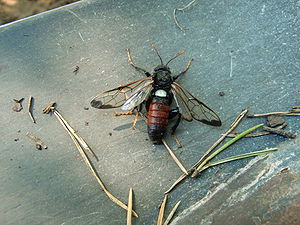Great birch sawfly
| Great birch sawfly | ||||||||||||
|---|---|---|---|---|---|---|---|---|---|---|---|---|

Great birch sawfly ( Cimbex femoratus ) |
||||||||||||
| Systematics | ||||||||||||
|
||||||||||||
| Scientific name | ||||||||||||
| Cimbex femoratus | ||||||||||||
| ( Linnaeus , 1758) |
The Big birch sawfly or birch button sawfly ( Cimbex femoratus ) is a plant Wasp (Symphyta) from the family of cimbicidae (Cimbicidae).
features
The wasps reach a body length of 20 to 28 millimeters and are among the largest cudhorn sawfly in Central Europe . The head is greatly enlarged behind the eyes, the mandibles are large and strong, the upper lip is small. They have a shiny black rib cage and a black or (especially in the males) red-brown abdomen. The first abdomen git is cut out in a semicircle with a membranous nakedness. The antennae are culled at the end, black at the base and otherwise yellow. The last leg segments are also colored yellow-orange. The wings are sharply darkened on the outer edge.
The after-caterpillar becomes approx. 45 millimeters long and is colored green. They look very similar to caterpillars . On their backs they have a dark, narrow vertical stripe, which is lined with a light yellow. Numerous whitish warts are distributed all over the body.
Occurrence
They occur all over Europe and Siberia .
Way of life
The species flies in May and June and is the most common of the genus in Central Europe. The animals "curl" young shoots of trees in order to get to the sap. They are usually high up in the treetops and are therefore rarely seen.
Food of the caterpillars
The caterpillars feed exclusively on birch leaves ( Betula spec. )
development
The females lay up to 200 eggs individually or in small groups with their ovipositor in "pockets" previously created on the underside of the leaves. The hatching caterpillars are very sluggish and stay on the underside of the leaves during the day. At night they become active and feed while sitting on the leaf margin. Within about three weeks, they multiply their initial weight from about 4 milligrams to 1,400 milligrams. Although individual animals can eat a large number of leaves, they do not cause much damage as their occurrence is usually rare. You can inject hemolymph at predators from a distance of up to 20 centimeters. The caterpillars go into the ground to pupate. There they make a permanent cocoon in which they winter. The actual pupation does not take place until the following spring. The wasps hatch in late April or May. It also happens that the pupae linger for several years.
Individual evidence
- ↑ ENSLIN, E. (1913) Contributions to the knowledge of the Tenthredinoidea I (Hym.). 1. Pteronidea flavescens Steph. and stichi nom. nov. 2. On the breeding of Cimbex femorata L. - Entomologische Mitteilungen 2, 321-327, Berlin-Dahlem
